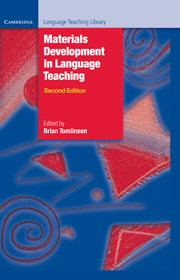Book contents
- Frontmatter
- Contents
- Preface
- Glossary of basic terms for materials development in language teaching
- Acknowledgements
- 1 Introduction: principles and procedures of materials development
- Part A Data collection and materials development
- 2 Using corpora in the language classroom
- 3 Concordances in the classroom without a computer: assembling and exploiting concordances of common words
- 4 Telling tails: grammar, the spoken language and materials development
- Comments on Part A
- Part B The process of materials writing
- 5 A framework for materials writing
- 6 Writing course materials for the world: a great compromise
- 7 How writers write: testimony from authors
- Comments on Part B
- Part C The process of materials evaluation
- 8 The analysis of language teaching materials: inside the Trojan Horse
- 9 Macro- and micro-evaluations of task-based teaching
- 10 What do teachers really want from coursebooks?
- 11 The process of evaluation: a publisher’s view
- Comments on Part C
- Part D The electronic delivery of materials
- 12 Developing language-learning materials with technology
- 13 New technologies to support language learning
- Comments on Part D
- Part E Ideas for materials development
- 14 Seeing what they mean: helping L2 readers to visualise
- 15 Squaring the circle – reconciling materials as constraint with materials as empowerment
- 16 Lozanov and the teaching text
- 17 Access-self materials
- Comments on Part E
- Conclusions
- Recommended reading
- Index
Comments on Part B
Published online by Cambridge University Press: 09 February 2023
- Frontmatter
- Contents
- Preface
- Glossary of basic terms for materials development in language teaching
- Acknowledgements
- 1 Introduction: principles and procedures of materials development
- Part A Data collection and materials development
- 2 Using corpora in the language classroom
- 3 Concordances in the classroom without a computer: assembling and exploiting concordances of common words
- 4 Telling tails: grammar, the spoken language and materials development
- Comments on Part A
- Part B The process of materials writing
- 5 A framework for materials writing
- 6 Writing course materials for the world: a great compromise
- 7 How writers write: testimony from authors
- Comments on Part B
- Part C The process of materials evaluation
- 8 The analysis of language teaching materials: inside the Trojan Horse
- 9 Macro- and micro-evaluations of task-based teaching
- 10 What do teachers really want from coursebooks?
- 11 The process of evaluation: a publisher’s view
- Comments on Part C
- Part D The electronic delivery of materials
- 12 Developing language-learning materials with technology
- 13 New technologies to support language learning
- Comments on Part D
- Part E Ideas for materials development
- 14 Seeing what they mean: helping L2 readers to visualise
- 15 Squaring the circle – reconciling materials as constraint with materials as empowerment
- 16 Lozanov and the teaching text
- 17 Access-self materials
- Comments on Part E
- Conclusions
- Recommended reading
- Index
Summary
The three chapters in this section offer very different perspectives on the process of creating language teaching materials, but they do share some themes and they do raise similar issues.
All three chapters stress the dynamic nature of materials development and reveal how materials, whether they be for publication or tomorrow’s lesson, need to be constantly evaluated and revised. Materials should keep changing, and, in fact, I even change my own published materials every time I use them in class. Ideally materials need to be monitored by the author(s), by other ‘experts’ not involved in the writing team and by typical users of the material. This is the process commonly adopted on textbook projects these days and which, in my personal experience, has been very successful in increasing the learning potential of books written in the 1990s for schools in Bulgaria, Morocco and Namibia (Tomlinson 1995 ) and more recently for materials for teachers in Ethiopia, for young professionals in Sub-Saharan Africa, for university students in Turkey and Vietnam, and for primary students in China. The Namibian Textbook Project is a particularly interesting example of dynamic development of materials. A team of 30 writers (teachers, curriculum developers and advisers) worked together for eight days to develop a book (On Target 1995). During that time the team used responses to teacher and student questionnaires plus their pooled experience and expertise to determine the content and approach of the book and then to draft, revise and write it. Later it was trialled by teachers throughout the country, monitored by ‘experts’ and then finalised. This collaborative, interactive approach is one I would recommend whether for global coursebooks, local textbooks or even institution- specific material .
Another theme common to the three chapters is that of meeting the needs of all the interested parties (a theme also discussed by Frances Amrani when she focuses on the monitoring of materials in Chapter 11 and by Hitomi Masuhara when she considers the needs of teachers in Chapter 10 ). Whilst most people would agree that meeting the needs of the learners should be the primary target, it is obviously important to meet the needs of the teachers, the writers and the ‘sponsors’ too.
- Type
- Chapter
- Information
- Materials Development in Language Teaching , pp. 174 - 176Publisher: Cambridge University PressPrint publication year: 2011



